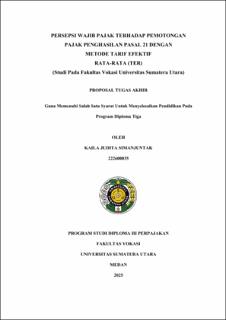| dc.description.abstract | This study investigates the perception of taxpayers, specifically Civil
Servant at the Faculty of Vocational, Universitas Sumatera Utara, regarding
Income Tax Article 21 witholding using the Average Effective Tariff method. The
background of this study stems from fluctuations in Income Tax Article 21 revenue
and the potential for taxpayers misunderstanding or dissatisfaction with the
Average Effective Tariff method, which was designed to simplify tax calculations.
Observations indicate objections from some employees concerning the varying
amounts of tax witheld, raising questions about their comprehension and the
perceived fairness of the tariffs.
The objectives of this research are to analyze lecturers' understanding of
the Average Effective Tariff method, to evaluate the perception of tax tariff
fairness and proportionality among lecturers, and to identify differences in the
perception of objections to Income Tax Article 21 witholding between lecturers
and administrative staff.
A quantitative descriptive comparative method was employed. The research
sample consisted of 30 respondents (15 lecturers and 15 administrative staff)
drawn from a population of 70 individuals at the Faculty of Vocational, Universitas Sumatera Utara, selected through Proportional Random Sampling.
Primary data were collected using Likert-scale questionnaires and subsequently
analyzed using descriptive statistics, validity, reliability, and normality tests, as
well as the Mann-Whitney U Test.
The findings reveal that most lecturers possess a reasonably good
understanding of the basic principles of the Average Effective Tariff method,
although variations persist in their technical calculation comprehension and the
clarity of explanations received. The perception of tax tariff fairness has not been
fully achieved, with some respondents still questioning the equity and
proportionality of the withholding, particularly concerning variable income. A
significant difference was found in the perception of tax witholding objections
between lecturers and administrative staff. Lecturers tended to feel more
financially burdened and were more proactive in expressing a desire to file
objections, whereas administrative staff more frequently expressed uncertainty,
indicating a lower level of tax system comprehension. These differences are
explained by equity theory, where lecturers with more complex income structures
are more sensitive to perceived discrepancies between tax inputs and outputs. | en_US |


